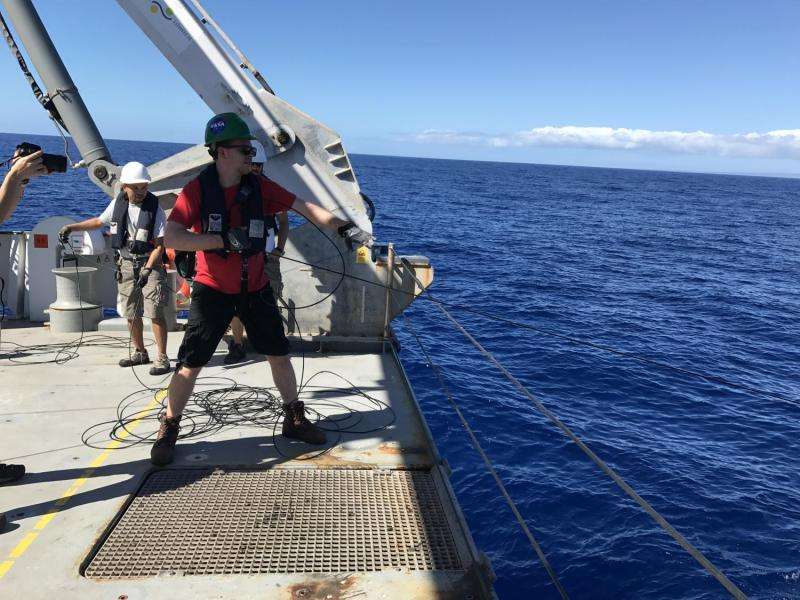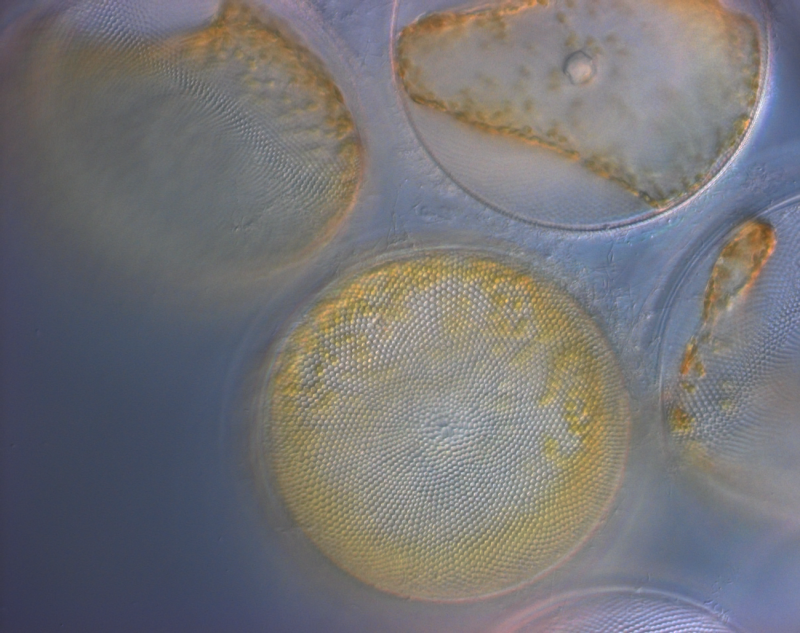NASA taking stock of phytoplankton populations in the Pacific

The microscopic size of phytoplankton, the plant-like organisms that live in the sunlit upper ocean, belies their importance in the global environment. They provide the food source for the zooplankton that ultimately feed larger animals ranging from small fish to whales. And like plants on land, phytoplankton use carbon dioxide from the atmosphere to grow and thrive through photosynthesis, which ultimately releases oxygen into the ocean and atmosphere.
Phytoplankton also play a large role in reducing carbon dioxide levels in the atmosphere: A recent study found that phytoplankton take in about 24 percent of this greenhouse gas. When they die and sink to great depths in the ocean, phytoplankton also move carbon dioxide out of contact with atmosphere. Among the most pressing questions scientists are investigating is how much of that carbon is being stored in the ocean over the long term. Another question is how rising carbon dioxide levels and associated changes in the ocean environment are affecting phytoplankton communities.
To tackle those questions, on Jan. 26 scientists from NASA's Goddard Space Flight Center in Greenbelt, Maryland, along with researchers from across the country embarked on 27-day seaborne campaign from Hawaii to Portland, Oregon, to categorize and observe phytoplankton populations and their environment. The team is working aboard the R/V Falkor, a research vessel owned and operated by the non-profit Schmidt Ocean Institute, which grants scientists use of the ship to advance oceanographic research.
Where carbon dioxide, once taken up, ends up in the global carbon cycle depends on the species of phytoplankton, said Goddard/USRA oceanographer Ivona Cetinic, the campaign's chief scientist. "Their size as well as their shape and color determine the role that they play," she said. "By knowing who's there, you can predict what's going to happen to that carbon."
For instance, the interactions between smaller phytoplankton and the organisms that eat them are mostly confined to the ocean's surface layer. The carbon they take up remains at the surface or eventually escapes back into the atmosphere. But organisms that eat larger types of phytoplankton, along with their waste, are more likely to sink deeper into the ocean. Uneaten, dead phytoplankton may also sink as they decompose.
"When phytoplankton pass below the surface layer and reach the deepest portions of the ocean, they sink out," Cetinic said. "That's key, because the carbon they have sequestered is removed from contact with the atmosphere."

Physical processes also play a role in phytoplankton diversity and carbon transport. A complex interplay of different water masses, often visible in ocean color imagery, allow for the formation of pockets of highly specific ecosystems. Furthermore, processes such as subduction, or mixing, present another pathway for carbon deposition into the deep ocean.
Ocean color is also an important indicator of phytoplankton health and activity, and so from above the water an instrument is collecting hyperspectral measurements (ocean reflectance greater than 100 colors), from the ultraviolet to the shortwave infrared bands of the electromagnetic spectrum. The data collected will inform NASA's current and planned ocean color satellite instruments, including the Plankton, Aerosol, Cloud, ocean Ecosystem (PACE) mission scheduled for launch in 2022.
Fourteen researchers are deploying a range of instruments to track phytoplankton communities as the R/V Falkor traverses the northern Pacific Ocean. They are continuously measuring phytoplankton diversity through either microscopic imagery, pigments analysis or analysis of their genomic material. For the first time, they are testing new NASA-funded technology that will allow them to collect measurements of particle size.
Similar measurements will be taken from deeper portions of the ocean using an apparatus called a rosette, which comprises a cluster of bottles that captures water at different depths and instruments to measure salinity, temperature, and oxygen. Such physical measurements give clues about environmental conditions that support specific phytoplankton types. These types will be additionally recognized using images collected by a holographic camera, which will then be reconstructed in virtual reality space.
An autonomous platform called a wirewalker will help to assess the physical environment as well as the flux of particles into the deep ocean. The wirewalker allows for a package of instruments to travel along a wire to as far down as 100 meters measuring temperature, salinity, oxygen, as well as phytoplankton biomarkers such as chlorophyll. An autonomous float will hover at the 100-meter depth and collect settling particles as they sink from the upper ocean.
Ocean color satellites afford a global view of phytoplankton, but PACE will be the agency's first hyperspectral (high spectral resolution) satellite and an improvement over its predecessors in that it will be able to distinguish between different kinds. All of the research on this seaborne campaign will enable improved satellite data product validation and development of unprecedented data products.
PACE project scientist Jeremy Werdell, who is co-investigator on the proposal for ship time on the R/V Falkor, said, "The goal of the cruise is to collect data that will help us better understand the imagery collected by ocean color satellites. Studying ocean color can tell us a lot about the ocean."
Provided by NASA




















